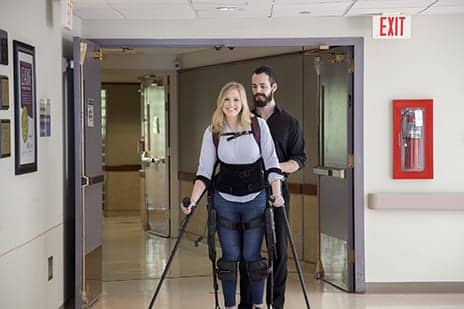
Long-term care hospitals provide life-transforming, highly technological care to the nation’s sickest, most devastatingly injured patients, according to a study by Gaylord Specialty Healthcare. Pictured here is a spinal cord-injured patient walking in a bionic exoskeleton at a long-term care facility. (Photo courtesy of Gaylord Specialty Healthcare)
Long-term care hospitals provide superior outcomes for the most severely ill patients than any other post-acute care setting, suggests a study from Gaylord Specialty Healthcare, based on 2016 data from the Centers for Medicare & Medicaid (CMS).
“Post-acute care plays a significant role in our health care system,” explains George Kyriacou, MSPH, president and CEO of Gaylord Hospital in Wallingford, Conn, during a presentation of the study during the recent American Medical Rehabilitation Providers Association Educational Conference and Expo in Boston.
“In 2016, approximately 43% of Medicare beneficiaries who were discharged from an acute-care hospital went on to receive post-acute care from skilled nursing facilities, home health agencies, inpatient rehab facilities or long-term care hospitals.”
“But when we analyze the range of patient acuity—or the rating that is given to each patient based on the severity of their illness with a rating of ‘1’ being the least ill and ‘4’ being the most severely ill—found in each post-acute care setting, it is clear that long-term care hospitals disproportionately shoulder the care of the largest population of the highest severity of illness compared to any other post-acute care setting.”
“On average, 57.1% of all patients in a long-term acute care hospital in 2016 were considered by Medicare to be of the highest acuity,” he continues, in a media release from Gaylord Specialty Healthcare. “In comparison, only 15.8% of the nation’s skilled nursing facilities’ patient population was comprised of patients of the highest acuity.”
The data indicates that although long-term care hospitals care for an overall sicker population, such institutions provide significantly better outcomes for patients of the highest acuity with:
- Up to 15.4% fewer hospital readmissions
- Up to 30.6% longer time to readmission
- Up to 31.7% lower outpatient emergency room utilization rates
than patients of the same severity of illness recovering in other post-acute settings.
“The Medicare data demonstrates what LTCHs have known all along: our nation’s sickest patients achieve significantly better outcomes in long-term care hospitals than in any other post-acute care setting,” he continues.
The data and conclusions outlined in the study come in stark opposition to the conclusion of a National Bureau of Economic Research (NBER) working paper, “Long-Term Care Hospitals, a Case Study in Waste,” released in August 2018, according to the release.
“Our findings do not align with the results of the NBER study which suggests that Medicare could realize $4.6 billion per year in savings with no harm done to patients by not allowing for discharge to LTCHs,” Kyriacou notes.
“Clearly based on our research, LTCHs are important to a healthier, safer health care system and are an important resource for our nation’s sickest patients.”
“I, along with many of our nation’s not-for-profit long-term care hospitals, hope that this research clearly demonstrates that patients of different acuity levels should be channeled to different settings in order to achieve the best outcomes at the very best cost,” he concludes.
[Source(s): Gaylord Specialty Healthcare, PR Newswire]


